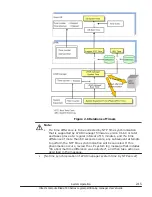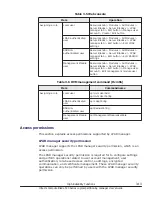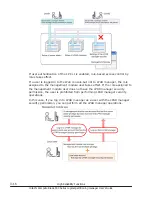
How to use the N+M cold standby from the viewpoint of the LPAR
manager configuration.
1
.
Make sure that all server blades that are targeted for N+M cold standby
group assignment can start in LP mode alone. Then, select Yes for Pre-
State Auto Activation on the LP Options screen and save the LPAR
manager configuration. After that, backup the LPAR manager
configuration.
If you have any plan to use the server blades in LP mode alone in the
step 7, perform them (this step) to all of the server blades.
2
.
After completing the adding active and standby server blades to the N+M
cold standby group, start LPAR manager on the active server blade and
boot the guest OS. After that, you can use the functionality of LPAR
manager.
3
.
If a failover occurs due to a failure on the active server blade or the N+M
failover test, LPAR manager automatically starts on the active server
blade (standby server blade before the failover) and the guest OS that
was operating until just before the failover also automatically starts. After
that, you can use the functionality of LPAR manager. The LPAR manager
configuration of the standby server blade (active server blade before the
failover) is cleared (undefined) in the process of the failover.
4
.
The failed standby server blade is repaired (or replaced) by maintenance
personnel. You are not required to perform the maintenance work. Do not
restore the LPAR manager configuration of the repaired (or replaced)
standby sever blade to keep it cleared.
5
.
For the N+M failback, you are not required to perform operations related
to the LPAR manager configuration. Do not restore the LPAR manager
configuration of the standby sever blade after the N+M failback to keep it
cleared.
6
.
You reassign the blade as active, the blade is automatically removed from
the N+M cold standby group. After the removed server blade is repaired
(or replaced), add the server blade to the N+M standby group again. Do
not restore the LPAR manager configuration to keep it cleared.
7
.
If you want to start a server blade in LP mode alone and the server blade
has failed over at least once, you need to restore the LPAR manager
configuration because the LPAR manager configuration of the server blade
is cleared. Perform the following procedure to restore the LPAR manager
configuration. If you perform the procedure in a wrong way, the WWN or
MAC address of the LPAR will be duplicated in another LPAR.
a
.
On the Web console, check that the LP IP Address and VNIC System
No. of the server blade that was removed from the N+M cold standby
group are blank. A server blade whose LP IP Address and VNIC
System No. are not blank was a standby server blade to which the
failover had never been performed, or an active server blade.
b
.
On the Web console, specify the LP IP Address and VNIC System No.
that were used to make the server blade sure to start in LP mode
alone in the step 1, for the blank LP IP Address and VNIC System No.,
and then start LPAR manager without restoring the LPAR manager
3-4
High Reliability Functions
Hitachi Compute Blade 500 Series Logical partitioning manager User's Guide






























